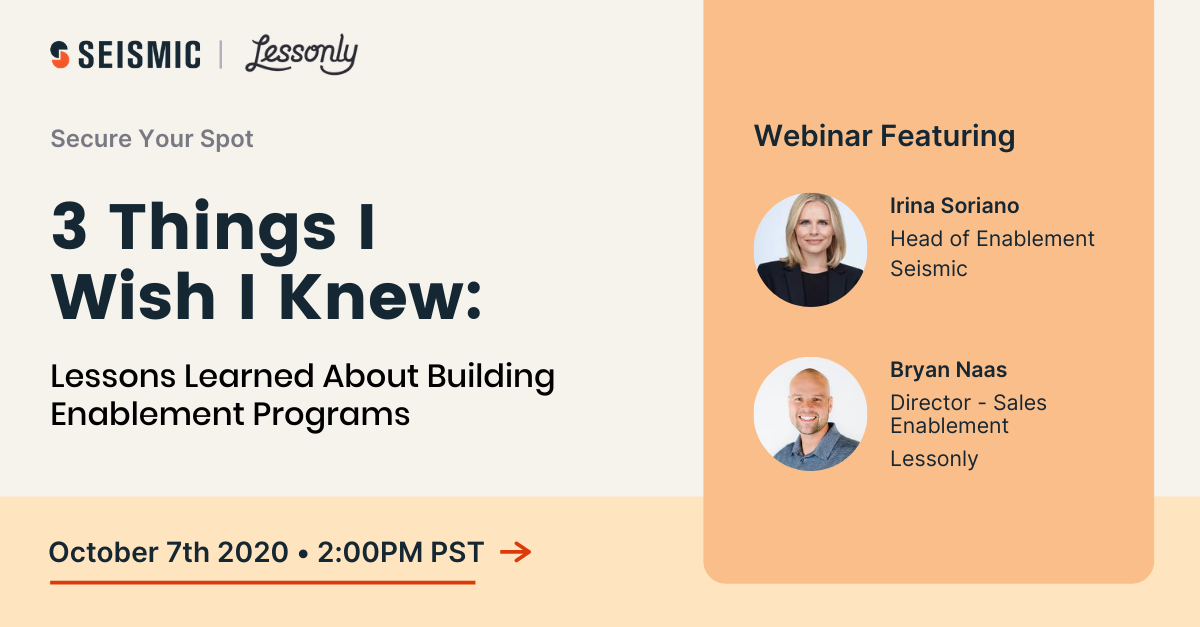What’s the most important aspect of any enablement campaign?
In my experience, the whole project hinges on the planning phase.
Admittedly, it can be hard at times to resist the urge to dive right into your project plan. But, it’s crucial to reflect on the good and the bad of past efforts, take the time to nail down what you’re trying to accomplish, consider who is affected, and determine why each aspect matters.
Want to learn how to better optimize your enablement efforts? Join Irina Soriano, Head of Enablement at Seismic and Bryan Naas, Director of Sales Enablement at Lessonly, for 3 Things I Wish I Knew: Lessons Learned About Building Enablement Programs on October 7th at 2 PM EST. Learn more and register here.
Below are five tangible steps that help serve as the building blocks to the most successful enablement campaigns.
1. Focus on the final goal
First thing’s first. You have to start with the end goal in mind. This does not simply mean “get everyone trained by a certain date.” Rather, this is about taking the time to understand what the business expects from the new initiative. For example, will a new product generate $X revenue in the next 24 months? Or, will a new software tool drive Y efficiency, which should lead to Z outcome for the team?
Important considerations: What are we aiming for? What are the hard numbers? Who cares about these results? Who all is involved in seeing the results through? How does it relate to your team’s skill set?
2. Remember your customers
Next, put yourself in the customer’s shoes. It’s easy to put yourself in your employees’ shoes first, but I think it’s important to resist the urge to do so. In reality, if your customers don’t care, then your employees will be frustrated. This is an easy concept when the enablement plan is something customer-facing, like a new product. But, it’s more difficult when it’s an internal project, like new technology or a new process. Either way, it’s important to consider how everything affects your customers and prospects since that’s ultimately who the entire organization serves.
Important considerations: What value does this deliver to our customers? How do we want to portray that value? What will they be skeptical about, and why?
3. Consider your reps
Then, and only then, is it time to put yourself in your reps’ shoes. It’s no doubt that they’re engaging with training and asking themselves, “What’s in it for me?” (Like it or not, we all know this is what they’re thinking). It’s helpful to set expectations at the beginning of training so reps know why they’re receiving that content, how long training will take them to complete, and what they should know about or understand by the end of enablement. This is the ultimate balancing act in delivering relevant information vs. all of the information.
Important considerations: How can we quickly and cleanly deliver information? What will be appropriate FAQs, and how do we address those? What will reps think is unimportant or just too much information? Will they be able to easily find information when they need to refer back to it at a later date?
4. Choose the right delivery methods
Next, it’s time to determine your content delivery process and cadence. During this time, it’s important to identify what information falls into “nice to know” versus “need to know.” It’s also beneficial to consider how sales manager training looks during this phase. This step has a few components. First, outline the content delivery process you plan to employ.
Important considerations: Do we do a live training session? Do we pair that with online delivery? Does the whole company need training? Are the marketing assets ready? Where will those live?
Then, determine your cadence. Remember, we’re all creatures of habit. So, remaining consistent from one campaign to the next is key. Reps desire uniformity across these campaigns in order to easily digest and compare pieces of information. For example, if you’re launching a new partnership, match your training to the same aspects you did with previous launches. In addition to consistency, another benefit here is saving time. In many cases, you can plug and play with previous material from one campaign to the next!
Important considerations: What have we done with similar campaigns in the past? What should we do differently, if anything? What date are we working back from?
Finally, consider how you and your stakeholders will know the team is enabled and ready for action. The default here are usually quizzes or assessments. Sometimes that’s too much, especially if it’s a super minor change. Sometimes that’s too little, if this is a larger change.
Important considerations: Is attending or taking the training enough? What will we know from quiz results? Is role-play, practice, and feedback necessary or overkill?
5. Identify successes and areas for improvement
And last, but certainly not least, it’s time to track the follow-through. This is when you need to go back to the outcomes. No one doubts this is important, but very few enablement leaders follow this through. In fact, I’ve been guilty of this myself. Beyond seeing if your campaign was a success, you can also learn from what worked and what didn’t. Ideally, you’ll drill into any gaps to improve the next campaign.
Important considerations: If it’s a new product release, see how that product is selling, or how many open deals have the product included. If it’s a new technology you’re rolling out, check out adoption. What lagging and leading indicators should you look at?
As you think through this process, evaluate how you can flex up for larger projects or down for smaller ones. Not only will this ensure consistency, but it will also help guarantee that you focus on the experiences your team needs to do its best work and make the biggest impact on your business.
